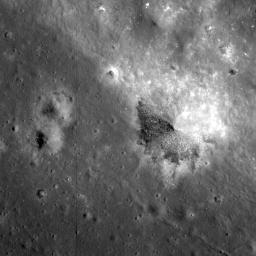
|
King Crater’s Unusual Melt Pond
- Click the image above for a larger view
- Full-Res JPEG (1000 x 1000) (131.5 kB)
- Full-Res TIFF (1000 x 1000) (1.0 MB)
Caption:
A Constellation Program Region of Interest near the northeast edge of the unusually large melt pond adjacent to the lunar far side crater King. The boundary between the dark, coherent impact melt rock at the lower left of the image and the bright, pulverized ejecta blanket to the upper right is clearly visible in the floor of a smaller crater that formed at the boundary between these two units. Image width is 1.3 km, pixel width is 1.29 m. Subset of NAC frame M106088433R.
Background Info:
NASA's Goddard Space Flight Center built and manages the mission for the Exploration Systems Mission Directorate at NASA Headquarters in Washington. The Lunar Reconnaissance Orbiter Camera was designed to acquire data for landing site certification and to conduct polar illumination studies and global mapping. Operated by Arizona State University, the LROC facility is part of the School of Earth and Space Exploration (SESE). LROC consists of a pair of narrow-angle cameras (NAC) and a single wide-angle camera (WAC). The mission is expected to return over 70 terabytes of image data.
Cataloging Keywords:
| Name | Value | Additional Values |
|---|---|---|
| Target | Moon | |
| System | Earth | |
| Target Type | Satellite | |
| Mission | Lunar Reconnaissance Orbiter (LRO) | |
| Instrument Host | Lunar Reconnaissance Orbiter | |
| Host Type | Orbiter | |
| Instrument | Lunar Reconnaissance Orbiter Camera (NAC) | |
| Detector | Narrow Angle Camera (NAC), Wide Angle Camera (WAC) | |
| Extra Keywords | Crater, Grayscale, Impact | |
| Acquisition Date | ||
| Release Date | 2010-01-26 | |
| Date in Caption | ||
| Image Credit | NASA/GSFC/Arizona State University | |
| Source | photojournal.jpl.nasa.gov/catalog/PIA12945 | |
| Identifier | PIA12945 | |
